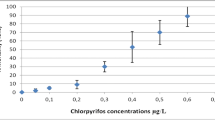Abstract
Microcosm trials were conducted with the botanical insecticide Margosan-O® to assess the potential hazards of the product to aquatic organisms. Laboratory chronic bioassays with water from the treated microcosms were conducted to provide an estimate of the residual effect of Margosan-O. Results from chronic tests showed Margosan-O toxicity to be greater in the laboratory exposures than in situ with Culicidae larvae exposed to the same concentrations. Residue analyses of the active ingredient, azadirachtin, determined that it had a half-life of 36 to 48 h in water exposed to natural sunlight. Two applications of Margosan-O at the recommended application rate for pests did not harm aquatic invertebrates that are categorized as planktonic and filter feeding (Culex sp. and Daphnia sp.). However, the benthic invertebrate (Chironomus riparius) was affected by multiple applications of neem. These results show that the use of Margosan-O and possibly other neem extracts in or near aquatic environments could lead to disturbances in benthic populations and may cause decreases in numbers of organisms that are important in food web and nutrient cycling processes.
Similar content being viewed by others
Author information
Authors and Affiliations
Additional information
Received: 21 June 1999/Accepted: 20 April 2000
Rights and permissions
About this article
Cite this article
Scott, I., Kaushik, N. The Toxicity of a Neem Insecticide to Populations of Culicidae and Other Aquatic Invertebrates as Assessed in In Situ Microcosms. Arch. Environ. Contam. Toxicol. 39, 329–336 (2000). https://doi.org/10.1007/s002440010112
Issue Date:
DOI: https://doi.org/10.1007/s002440010112




